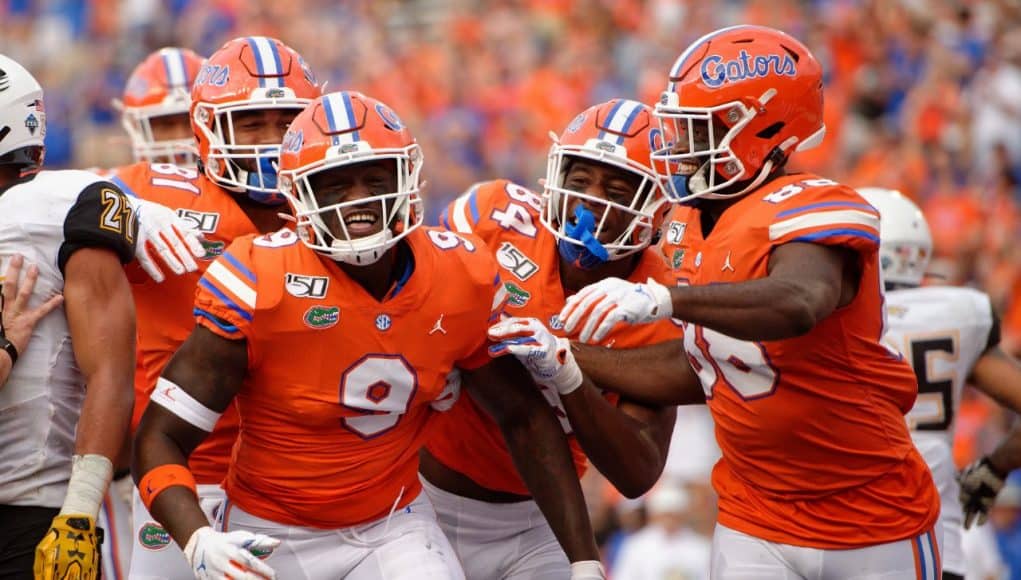Since Billy Napier was hired on Nov. 28, much of the discussion surrounding the Gators has been about the future. With the splash that Napier made on early national signing day and the seemingly never-ending staff that he’s putting together, fans have reason to believe that brighter days might be on the horizon.
However, it’s almost time to stop dwelling on the future and start thinking about what the 2022 season might entail for the Gators. They’ll begin spring practice in about a month.
Over the next month or so, we’ll break down what to watch for from each position during the spring. We’ll continue today with the tight ends.
The Returnees
Nick Elksnis, Jonathan Odom, Gage Wilcox and Keon Zipperer
This position will have a completely different feel to it following the transfer of Kemore Gamble, who was far and away the most productive tight end last year.
There is some talent left behind to fill this void. Zipperer was the No. 2-ranked tight end in the 2019 class but hasn’t lived up to the billing yet. He’s caught 25 passes for 309 yards and three touchdowns in three years. Even without Kyle Pitts playing most of the snaps in 2021, he caught just 11 passes for 133 yards.
Zipperer has good speed but needs to improve his route-running so that he can get open more often. He also needs to improve his blocking.
Odom has appeared in 11 games over the last two years, mostly on special teams. He’s much more advanced as a blocker than as a receiver, which could make him a good fit for the in-line role when Napier deploys his many two-tight-end sets.
Elksnis and Wilcox were both freshmen who redshirted last year. With Gamble out of the picture and Odom not being much of a factor in the passing game, they should receive more opportunities this spring.
The Newcomers
None
The Gators signed three tight ends in the 2022 class, but all three of them won’t enroll until the summer. UF will go through spring practice with just the four returning players.
Breakout Watch
Nick Elksnis
He has the perfect skillset for the modern game. He’s 6-foot-6 and 232 pounds and yet runs like a wide receiver.
His teammates and coaches raved about how many special plays he made in practice last year, and he made a couple of tough catches in the air between defenders during some of the clips they showed on Instagram Live.
Elksnis isn’t as good as Pitts, obviously, but he could present defenses with a similar type of matchup problem.
However, despite all of the preseason acclaim that he received last year, he played in only four games and didn’t catch a pass, in a bit of a head-scratching move.
If he continues to make plays and improves his blocking this spring, he won’t have to worry about watching games from the sideline during the fall.
Three Questions
1. What will Napier’s preference for two-tight-end sets mean for the players?
His base offense is expected to include two tight ends on the field. That could mean that you’ll almost have two separate positions under one umbrella. Zipperer and Elksnis are the glorified wide receivers that figure to spend a lot of time lined up out wide, and Odom is basically an extension of the offensive line. Wilcox falls somewhere in between.
What is that going to look like as far as practice is concerned? Are they going to have two of the players going through receiving drills while the other two work on blocking, perhaps even with an offensive line coach, or is this still going to be treated as one position?
2. What type of coaching style will William Peagler bring to the position?
Peagler is one of the least-known hires that Napier has made. Pretty much everybody knew about Rob Sale, Jabbar Juluke and Corey Raymond. Peagler was kind of tucked away coaching running backs at Michigan State, so there seemed to be a “Who the heck is that?” type of sentiment when the hire was announced.
That doesn’t mean that he won’t be an excellent coach, but it will be interesting to learn more about him this spring.
3. How many of these players will still be here by the fall?
With the three signees enrolling over the summer, the Gators are currently on track to have seven scholarship tight ends on the roster in the fall.
That seems highly unlikely, as there just aren’t going to be enough reps or enough catches to please everybody. Most coaching staffs like to have four or five tight ends on the roster. For the Gators to reach that number, at least two players are going to have to transfer after the spring.
It’ll be fascinating to see how the coaches manage the numbers at this position.


